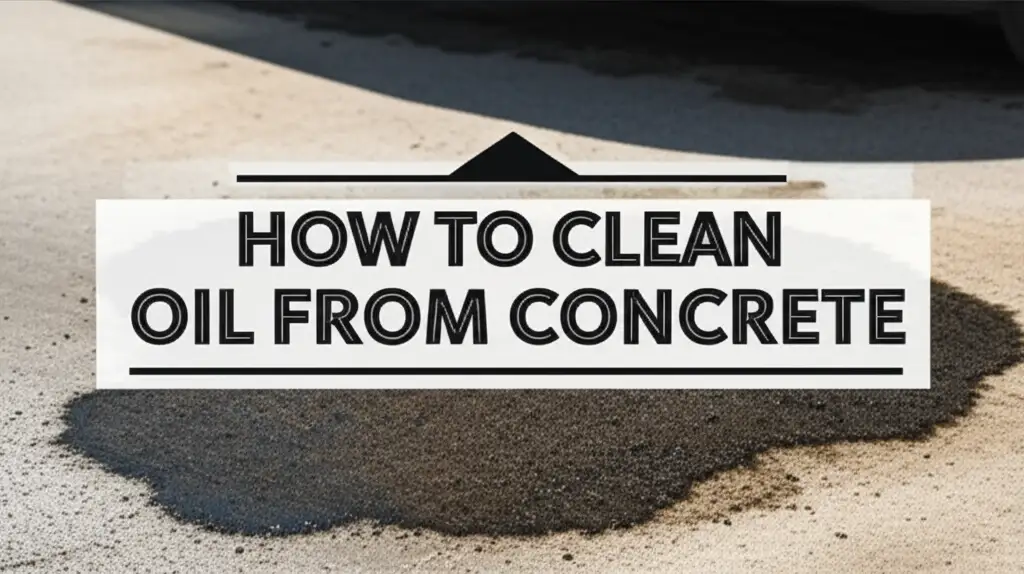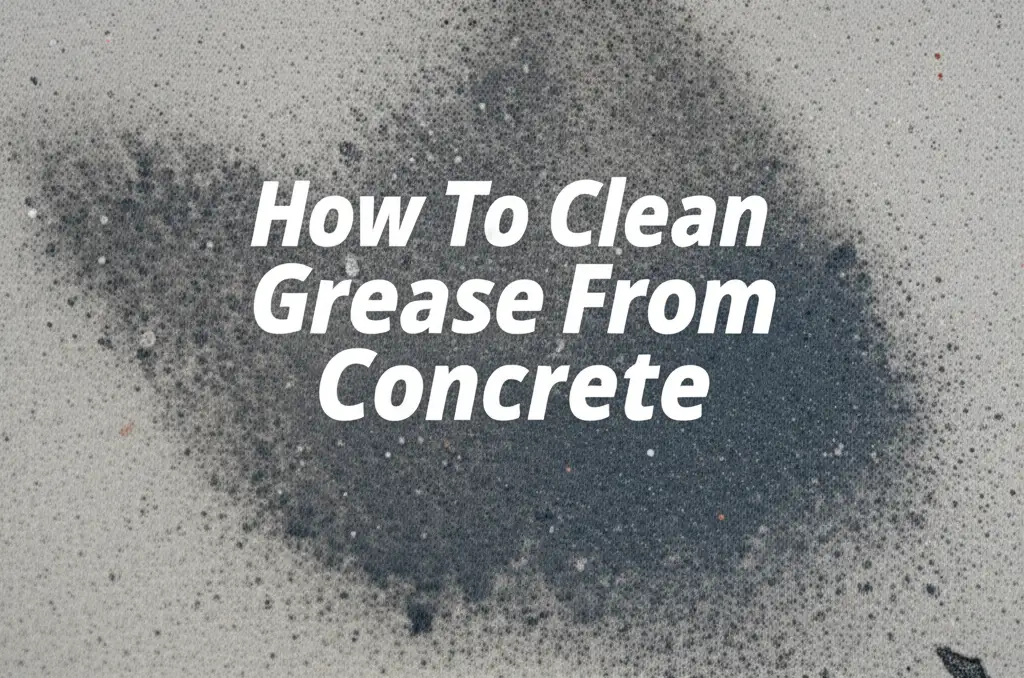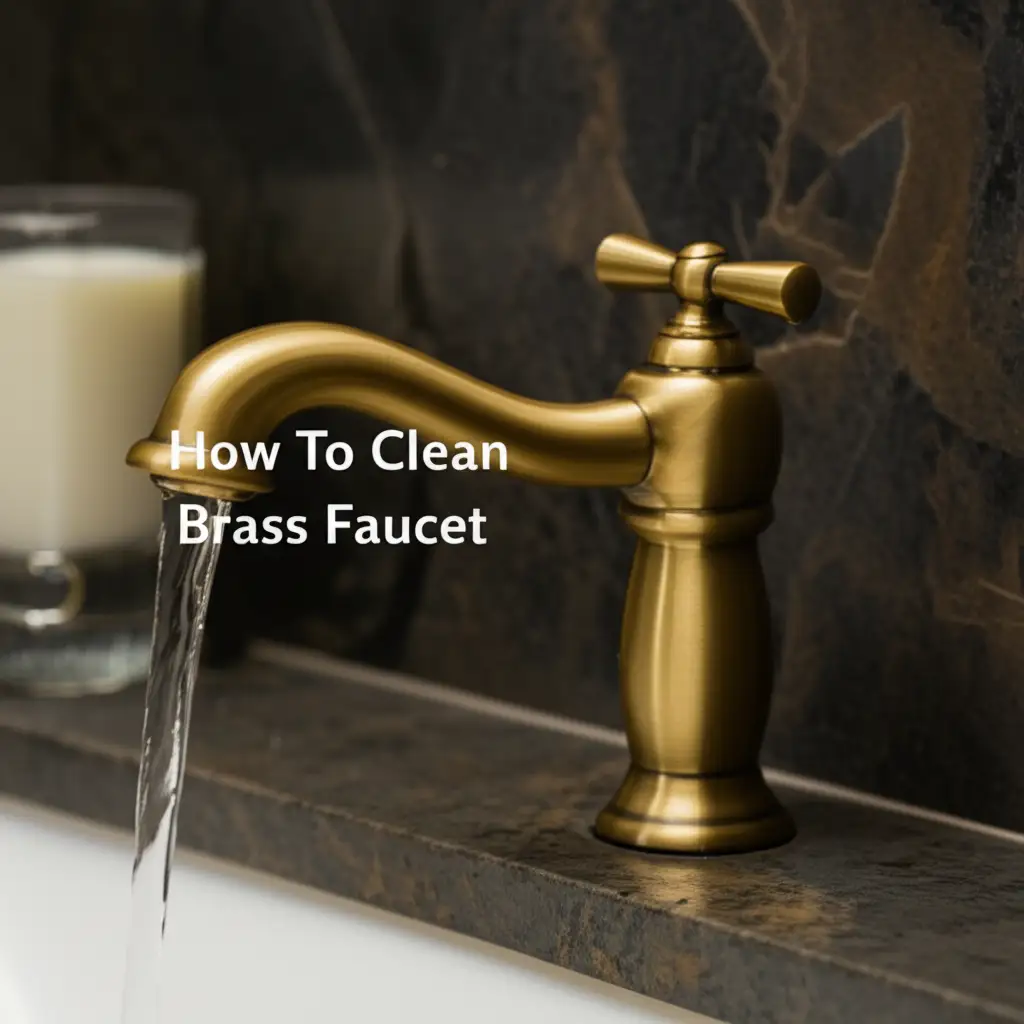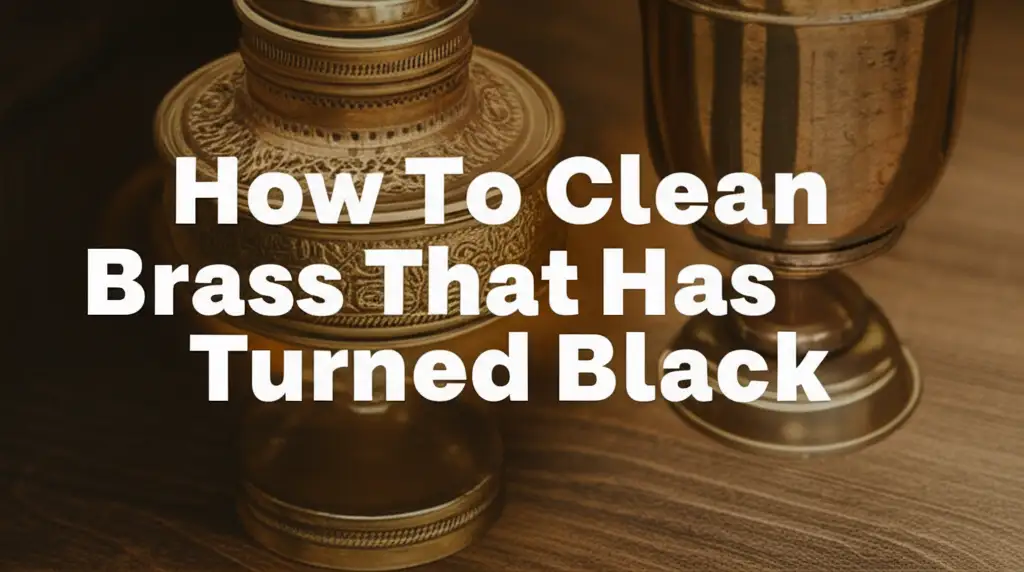· Home Cleaning · 16 min read
How To Clean Oil From Concrete

Remove Oil Stains: How to Clean Concrete Effectively
Oil stains on concrete surfaces can seem like a permanent eyesore. They often appear on driveways, garage floors, and patios. When you see an oil stain, you might feel frustrated. But don’t worry. Learning how to clean oil from concrete is simpler than you might think. Many methods exist to tackle these common spills.
This guide will walk you through the process of cleaning oil stains. We will cover why oil stains concrete and the materials you need. You will learn steps for fresh spills and stubborn, old marks. We will also look at different types of oil and surfaces. Finally, you will find tips to prevent new stains from forming. My aim is to help you restore your concrete’s look. Let’s get started on making your concrete clean again.
Takeaway
Cleaning oil from concrete requires quick action and the right tools. Here is what you need to remember:
- Act fast on fresh spills.
- Use absorbent materials first.
- Apply suitable degreasers or poultices.
- Rinse the area thoroughly.
- Consider sealing concrete for future protection.
Main Query Answer
To clean oil from concrete, act quickly to absorb fresh spills with materials like cat litter or sand. For set-in stains, apply a strong degreaser or a homemade poultice. Allow it to penetrate, scrub vigorously, then rinse the area well with water.
Understand Oil Stains on Concrete
Oil stains appear frequently on concrete surfaces. These stains can make an otherwise clean area look messy. Knowing why oil stains concrete helps you clean it better. It also guides your prevention efforts.
Concrete is a porous material. This means it has tiny holes or pores. Oil can seep into these pores easily. Once oil gets inside, it spreads. It then binds to the concrete’s structure. This creates a dark, noticeable mark. The oil’s dark color contrasts sharply with the lighter concrete. This makes stains very visible. The longer oil sits on concrete, the deeper it penetrates. This makes old stains harder to remove than fresh ones.
Why Oil Stains Concrete
Concrete absorbs liquids like a sponge. When oil spills, it does not just sit on top. It sinks down into the surface. This absorption happens quickly. The oil fills the small air pockets within the concrete. This process changes the concrete’s appearance. It creates a darkened area that can be slippery and unattractive.
The type of oil also matters. Engine oil, cooking oil, or hydraulic fluid each behave differently. Some oils are thicker. They may penetrate slower. Other oils are lighter. They might spread wider and deeper. Regardless of the oil type, the porous nature of concrete allows it to absorb the liquid. This absorption is why you see the persistent dark spots. Understanding this helps you choose the right cleaning method. It informs you about how deep the stain might be.
Fresh vs. Old Stains
The age of an oil stain is a critical factor. Fresh oil spills are much easier to clean. The oil has not had time to fully bond with the concrete. It has not seeped deep into the material yet. You can often remove fresh spills using simple absorbents and a basic cleaner. Quick action makes a big difference here.
Old stains are different. They have been on the concrete for a while. The oil has dried and settled deep into the pores. It forms a strong bond with the concrete. This makes old stains very challenging. They often need stronger cleaning agents. Sometimes they require specialized techniques. These include poultices or industrial degreasers. You might need to try a few methods for old stains. Removing stains from concrete often takes patience. For more general advice on tackling various marks, you can learn how to clean stains from concrete.
Gather Your Tools and Materials
Before you start cleaning oil from concrete, gather all your supplies. Having everything ready saves time. It also makes the cleaning process smoother. You need a mix of absorbents, cleaning agents, and safety items. The right tools help you remove the oil effectively.
Preparation is a key step. It sets you up for success. Do not skip this part. Think about the size of the stain and its age. This helps you choose the right strength of products. Make sure you have enough of each material. This prevents interruptions during cleaning.
Essential Absorbents
Absorbent materials are your first line of defense. They soak up fresh oil. This stops the oil from sinking deeper into the concrete. You want materials that absorb liquids well. Common choices are easy to find.
Here are some effective absorbents:
- Cat Litter: Clay-based cat litter works very well. It is highly absorbent. Sprinkle a generous layer over the fresh oil. Allow it to sit for several hours or overnight.
- Sand: Regular play sand or construction sand can also absorb oil. It is often readily available. Spread a thick layer over the spill. Let it soak up the oil for a while.
- Sawdust: If you have access to sawdust, it is another good option. It is light and porous. Sawdust absorbs oil effectively.
- Baking Soda or Cornstarch: For smaller, fresher spills, these household items work. They pull oil from the surface. Sprinkle a thick layer and let it sit.
Remember to sweep up the absorbent material carefully after it has soaked up the oil. Dispose of it properly according to local waste guidelines. For more tips on managing spills, see our guide on how to clean up spilled oil.
Cleaning Agents You Need
Once you remove the bulk of the oil, you need a cleaning agent. These products break down the oil residue. They help lift the stain from the concrete. Choose a product based on the stain’s severity.
Here are common cleaning agents:
- Dish Soap: Basic dish soap is surprisingly effective for fresh, light oil stains. It is a degreaser. Mix it with hot water.
- Heavy-Duty Degreaser: For tougher, older stains, you need a stronger product. Look for degreasers specifically designed for concrete. These products contain powerful chemicals. They break down oil and grease.
- Trisodium Phosphate (TSP): TSP is a very strong cleaner. It works well on old, deep stains. Use it with caution. Follow all safety warnings on the label.
- Laundry Detergent: Powdered laundry detergent can also work as a degreaser. It contains enzymes that break down oils. Mix it into a paste with water.
- White Vinegar: While less potent than degreasers, vinegar can help with light stains. Its acidic nature can lift some oil residue.
Always test any cleaning agent in a small, hidden area first. This checks for any adverse reactions or discoloration.
Safety Gear First
Safety is very important when cleaning oil from concrete. Many cleaning agents are harsh chemicals. They can irritate your skin, eyes, or lungs. Protect yourself before you begin.
Essential safety gear includes:
- Gloves: Wear chemical-resistant gloves. Nitrile or rubber gloves are good choices. They protect your hands from direct contact with cleaners.
- Eye Protection: Safety glasses or goggles are a must. Splashes of cleaner can harm your eyes.
- Ventilation: Work in a well-ventilated area. Open garage doors and windows. If working indoors, use fans. This helps disperse fumes from strong chemicals.
- Respirator or Mask: For very strong degreasers or TSP, consider wearing a respirator mask. This protects your lungs from chemical vapors.
- Old Clothes: Wear clothes you do not mind getting dirty. Some cleaners can bleach or damage fabric.
Always read the product labels for specific safety instructions. Follow them carefully. Your health is more important than a clean floor.
Step-by-Step Guide for Fresh Oil Spills
A fresh oil spill on concrete is an urgent matter. The faster you act, the easier it is to clean. Prompt action stops the oil from soaking deeper. It limits the stain’s spread. I have handled many spills. I know that speed is your best friend here.
This section covers the immediate steps. We focus on absorbing the oil. Then, we clean the remaining residue. These steps are simple but effective for new spills. You can prevent a major headache by addressing fresh oil right away.
Act Quickly to Absorb
The first and most important step is absorption. As soon as you see a fresh oil spill, grab an absorbent material. Do not rub the oil. Rubbing pushes it deeper into the concrete. Instead, aim to soak it up.
Here is how to do it:
- Cover the Spill: Pour a generous amount of your chosen absorbent material over the entire oil spill. Use cat litter, sand, sawdust, or even baking soda. Make sure the oil is completely covered.
- Allow Absorption Time: Let the absorbent material sit. For small spills, 15-30 minutes might be enough. For larger ones, allow several hours. The material needs time to draw the oil out of the concrete.
- Sweep Up: Once the absorbent looks saturated or dry, sweep it up. Use a stiff broom and dustpan. Dispose of the oily material properly. Check local regulations for hazardous waste.
- Repeat if Needed: If the stain is still very dark, repeat the absorption step. Apply a fresh layer of absorbent. Let it sit again. This removes as much loose oil as possible before you move to cleaning.
This initial absorption phase is crucial. It removes the bulk of the oil. This makes the next cleaning steps much more effective. Remember, the goal is to lift the oil, not spread it around.
Apply the Cleaning Agent
After absorbing the excess oil, you will still have a residue. This is where your cleaning agent comes in. The cleaner will break down the remaining oil. It helps to lift it from the concrete’s pores.
Follow these steps for applying the cleaning agent:
- Choose Your Cleaner: For fresh spills, dish soap and hot water often work well. You can also use a mild degreaser.
- Prepare the Mixture: If using dish soap, mix a generous amount with a bucket of hot water. If using a concentrated degreaser, follow the manufacturer’s dilution instructions.
- Apply to the Stain: Pour or spray the cleaning solution directly onto the oil stain. Make sure the stain is fully saturated.
- Let it Sit: Allow the cleaning agent to sit on the stain for 10-15 minutes. This gives it time to break down the oil. Do not let it dry completely. You can re-wet it if needed.
The cleaning agent starts working on the oil at a chemical level. It helps to loosen the grip of the oil on the concrete. This prepares the stain for scrubbing.
Scrub and Rinse
Scrubbing helps to dislodge the broken-down oil from the concrete. Rinsing then washes it away. This combination removes the stain effectively. It reveals cleaner concrete.
Here is how to scrub and rinse:
- Scrub Vigorously: Use a stiff-bristled brush or a push broom. Scrub the treated area with force. Work the cleaning solution into the stain. Scrub in circular motions. Then scrub back and forth. This action helps to lift the oil. It also pushes the cleaner deeper into the concrete pores.
- Rinse Thoroughly: After scrubbing, rinse the area with a garden hose. Use a strong stream of water. Make sure to rinse away all cleaning solution and lifted oil. You might need to rinse multiple times. Ensure no soapy residue remains.
- Inspect and Repeat: Let the concrete dry. Once dry, inspect the area. If a faint stain remains, you may need to repeat the process. Sometimes a second application of cleaner and scrubbing is necessary.
Remember that a clean garage floor is important for your home. You can find more comprehensive advice on how to clean oil off a garage floor for specific guidance. By following these steps, you can effectively tackle most fresh oil spills on your concrete.
Effective Methods for Old, Set-In Oil Stains
Old oil stains are a different challenge. They have had time to dry and set into the concrete. Simple absorbents and light scrubbing often do not work for them. For these stubborn marks, you need stronger methods. I have found that persistence is key when dealing with old stains.
This section covers more intensive cleaning techniques. These methods are designed to penetrate deep. They break down old, dried oil. Be ready for a bit more effort. But the results are worth it.
Poultice Method for Deep Stains
The poultice method is highly effective for deep, old oil stains. A poultice is a paste that pulls stains out of porous materials. It works by drawing the oil up from the concrete as it dries. This method requires some time, but it yields good results.
Here is how to create and use a poultice:
- Choose Your Absorbent Base: Mix an absorbent powder with a strong liquid degreaser. Good absorbent powders include diatomaceous earth, talcum powder, or even cat litter (crushed finely). For the liquid, use a commercial concrete degreaser or mineral spirits.
- Create the Paste: Slowly add the liquid degreaser to the absorbent powder. Stir until you have a thick, peanut butter-like consistency. It should be spreadable but not runny.
- Apply the Poultice: Spread a thick layer (about 1/4 to 1/2 inch) of the paste over the entire oil stain. Make sure the poultice extends slightly beyond the stain’s edges.
- Cover and Wait: Cover the poultice with plastic sheeting. Tape the edges down to prevent it from drying too quickly. This keeps the solvents active. Let it sit for 24-48 hours. The longer it sits, the more oil it can pull out.
- Remove and Rinse: After the waiting period, remove the plastic. Let the poultice dry completely. As it dries, it absorbs the oil. Once dry, it will turn into a crumbly powder. Scrape it up with a plastic scraper or stiff brush. Sweep away the residue.
- Rinse Thoroughly: Rinse the area with clean water. You may need to scrub lightly with a brush and rinse again. Let the concrete dry completely to see the results. You might need to repeat this process for very stubborn stains.
This method works wonders because it provides extended contact between the cleaner and the stain.
Using Heavy-Duty Degreasers
For old oil stains, a standard dish soap might not be strong enough. You need a heavy-duty degreaser. These products are formulated to break down tough oil and grease. Many are available at home improvement stores.
Steps for using heavy-duty degreasers:
- Pre-Wet the Area: Lightly wet the concrete around the stain. This helps prevent the degreaser from spreading and staining other areas. Do not soak the stain itself.
- Apply the Degreaser: Pour or spray the degreaser directly onto the old oil stain. Ensure full coverage. Follow the product’s instructions for application amounts.
- Allow Dwell Time: Let the degreaser sit on the stain for the recommended time. This is usually 10-30 minutes. The product label will tell you the exact time. The degreaser needs time to penetrate the oil.
- Scrub Hard: Use a stiff-bristled brush or a push broom. Scrub the stain vigorously. Work the degreaser into the concrete. Apply consistent pressure. For tough oil, a good scrub makes a big difference. For removing grease stains, specifically, check out how to clean grease from concrete.
- Rinse Completely: After scrubbing, rinse the area with a strong stream of water from a garden hose or pressure washer. Make sure to remove all degreaser residue and lifted oil. Any remaining degreaser can leave a new stain.
Remember to wear appropriate safety gear. Heavy-duty degreasers can be harsh.
Pressure Washing Techniques
A pressure washer can be a powerful tool for cleaning old oil stains. The high-pressure water helps to blast away loosened oil and dirt. However, use it carefully. Improper use can damage your concrete.
Tips for pressure washing oil stains:
- Pre-Treat the Stain: Always pre-treat the oil stain with a degreaser first. Apply the degreaser. Let it sit for the recommended time. Scrub the stain as much as possible before pressure washing. This softens the oil. It makes the pressure washer more effective. For engine oil specific stains, review how to clean engine oil off concrete for extra tips.
- Use the Right Nozzle: Start with a wide-angle nozzle (25-degree or 40-degree). These nozzles are less aggressive. They reduce the risk of concrete damage. Avoid using a zero-degree (pencil jet) nozzle. This can etch or permanently damage your concrete.
- Maintain Distance: Hold the pressure washer wand at least 6-12 inches away from the concrete surface. Adjust the distance as needed. Closer distances provide more pressure. Too close can cause damage.
- Overlap Strokes: Work in small, overlapping sections. Keep the wand moving constantly. This ensures even cleaning. It also prevents streaks or lines on the concrete.
- Rinse Thoroughly: After pressure washing, rinse the entire area with a garden hose. This washes away any remaining oil or cleaner. It leaves the concrete clean.
Pressure washing alone may not remove all oil. It works best when combined with a good degreaser. It is a great finishing step. It gives a deep clean.
Special Considerations for Different Oil Types and Concrete Surfaces
Not all oil stains are the same. Different types of oil behave differently on concrete. The surface of your concrete also matters. A driveway might react differently than a garage floor. Pavers have unique needs. Understanding these differences helps you pick the best cleaning strategy. This tailored approach improves your chances of success. I always consider the specific situation before cleaning.
Engine Oil vs. Cooking Oil
The source of the oil affects how you clean it. Engine oil and cooking oil have different compositions. This impacts their stain removal.
- Engine Oil Stains: Engine oil is typically thick and dark. It often contains additives and carbon. This makes it challenging to remove. Engine oil penetrates concrete deeply. It leaves a very dark stain. You will usually need heavy-duty degreasers or poultices for engine oil. Hot water can help break down engine oil. For detailed advice, you can revisit how to clean engine oil off concrete.
- Cooking Oil Stains: Cooking oils, like vegetable oil or olive oil, are generally lighter. They are often less viscous. They might not penetrate as deeply as engine oil. Fresh cooking oil spills can often be cleaned with strong dish soap and hot water. Baking soda or cornstarch are also good for absorbing fresh cooking oil. Old cooking oil stains still require degreasers. But they might not need treatments as strong as engine oil.
Always identify the oil type if you can. This helps you choose the most effective cleaner.
Driveways vs. Garage Floors
Concrete surfaces around your home serve different purposes. This affects how they get stained and how you clean them.
- Driveway Concrete: Driveways face outdoor elements. They are exposed to rain, sunlight, and varying temperatures. These factors can make oil stains set in more quickly. Driveways often have coarser finishes. This can make scrubbing a bit harder. But it also means they might hide minor imperfections better. Large driveways might benefit from pressure washing after treatment.
- Garage Floor Concrete: Garage floors are typically indoors. They are shielded from rain. This means stains might stay fresher longer. But garage floors also see more direct vehicle traffic. They often collect more engine oil and grease. Garage floors can sometimes be sealed. A sealed surface is easier to clean. Unsealed garage floors will absorb oil readily. For comprehensive care of your garage floor, see how to clean a garage concrete floor.
Consider the specific use and environment of your concrete. This will help you decide on the best approach for oil stain removal.
- concrete cleaning
- oil stain removal
- garage floor cleaner
- driveway cleaning
- oil absorbent
- degreaser
- home maintenance




